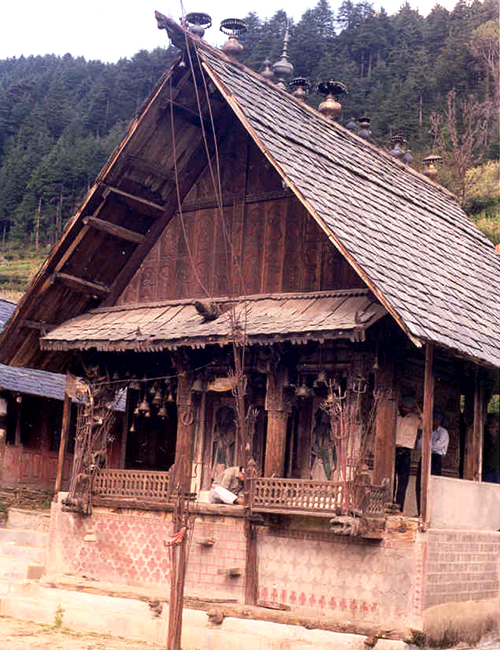
CHAUNDA(Chamunda) DEVI TEMPLE, DEVIKOTHI, CHAMBA:
The Chamunda temple at Devi Kothi (earlier called Devi-ri-Kothi) is one of the important wooden temple of the later medieval period of Chamba. Situated 130 kilometres from Chamba towards the north, Devi Kothi has been one of the important parganas of the erstwhile Chamba State.
According to the inscription in Tankari on the wooden panels beside the main door, Raja Umed Singh (AD 1748-1764) of Chamba built this temple, in AD 1754.
The principal temple in the complex is dedicated to Chamunda Devi, locally called Chaunda Bhagwati,is a much-refurbished structure, mostly made of wood and slates for roofing. The woodcarving of this temple deserves notice for the bold and heroic treatment of certain human figures, representing various mythological characters. Many of these are inspired by the Shaiv and Shakti tantric cults. While some of these are quite old, may be of the time when this temple was founded, but many of these are of recent workmanship. The fronting gable of this temple is treated with the bas-relief carving of the male musicians and dancers, all clad in the typical medieval costumes. The central post is treated with the figures of gods and goddesses in different postures. The grabh-grih enshrines a folkish brass image of Mahishasurmardani, installed on a high pedestal, which carries an inscription at its base.
The outer surfaces of the four-walls of grabh-grih are embellished with the interesting murals. These murals on stylistic consideration may be placed to the first quarter of the nineteenth century. Executed on different panels, these carry themes drawn from the BhagvatPuran. Three of these panels are devoted to the Krishn theme, in which he is shown froliking with the gopis.
KAMLAH FORT, SARKAGHAT, MANDI
The erstwhile state of Mandi was in ancient times supposed to have contained 360 forts, but of these, only ten are now in existence and rest all are disappeared. The Kamlah fort is one of those forts of Mandi, which are lying in bad state of preservation. This fort was built by Raja HariSen of Mandi state in 1625-30 A.D. and was strongly fortified by his son Raja Suraj Sen. According to another legend, Baba Kamlahia, a renowned saint appeared in the dream of Raja SurajSen and ordered him to construct a fort and temple at this place which will be invincible. Raja obeyed the orders of saint and constructed this magnificent fort at this hillock which is an inhospitable place. The fort was named as Kamlah fort, after this saint.
Fort has six distinct forts along the serrated ridge of SikandarDhar, on the border of Mandi and Kangra, and is a conspicuous object from a long distance all around. The cliffs are almost perpendicular on three sides. The six distinct forts, viz; kamlah, Chauki, Chabara, Pdampur, Shamsherpur, and Narsingpur. Although like Anantpur impregnable on two sides and nearly so on the third, where the gateway is reached by a ladder of about 40 steps, yet the eastern side might be easily occupied by an enemy if once in possession of Padampur. There is no spring of water in Kamlah itself, the spring for the supply the place being some distance below, but all like hill forest it contains excellent tanks in which sufficient water for the supply of a small garrison for several months might easily be stored.
Kamlah was the treasure house for all the wealth of Mandi state from the reign of SurajSen to that of IshwariSen, and the independence of the state has often depended on its chief fortress, which still held by a small garrison. The fort faced many bad incidents. In 19th century A.D., it was brought to ground after a treaty signed with British government on 24th October 1846.
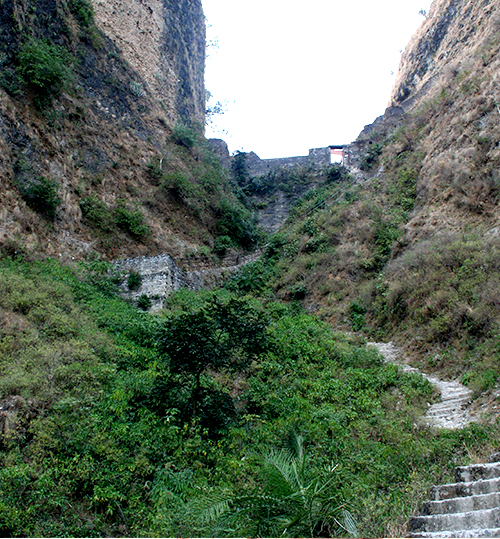
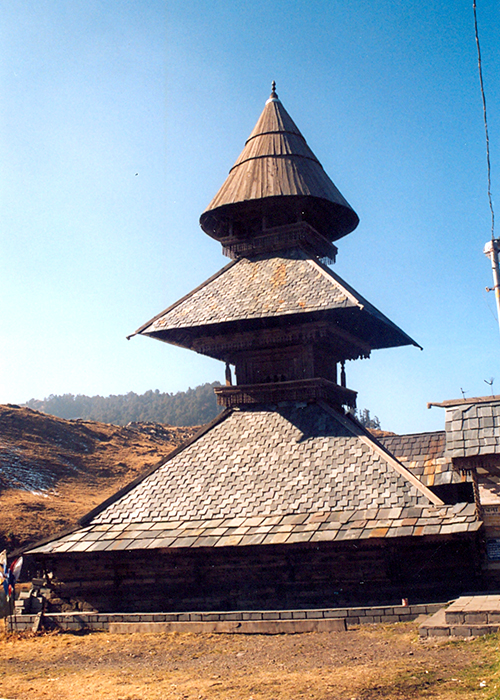
PARASHAR TEMPLE, MANDI
This lakeside temple site is now accessible from Mandi and Bajaura towns through a 20 kilometres long curvy and steep lateral fair-weather road, which off takes at Bagi, a wayside village about 28 kilometres from Mandi between Kataula and Dulchi Pass on the Mandi-Dulchi Pass (2061metres above MSL)-Bajaura road.
Situated on its verge of this lake, is the age-old magnificent and lofty wooden temple of Parashar Rishi. This curiously attenuated temple may be the most interesting and significant example of the multi-tiered pyramidal (hansakara) temple that has provided prototype to the numerous similar wooden temples of the Himalayan region. This temple was built in AD c.1340 by Raja Ban Sen (c.1301-1346 AD), one of the earliest rulers of the erstwhile Mandi kingdom.
The temple is laid out in the quadratic formation around the rectangular sanctum, enclosed by the immaculately built timber-bonded stone four-wall. A richly carved single shutter deodar wood door provides entry to the sanctum. Leaving an about one metre wide space all around the sanctum for ambulatory, another four-wall is provided. Beyond the outer four-wall, there is an open passage around the temple. According to the original planning, twelve massive deodar wood pillars, four on the corners and eight in between, on the outer edge of this open passage supported the roof-ends of the massive superstructure.
MAHADEV BHUVNESHWAR TEMPLE, RAJNAGAR, CHAMBA
Located about 13 kilometres from Chamba on the Chamba-Tissa Road, this village is accessible by a link road to the village.This temple may be the only monument that reflects certain typical characteristics of the Kashmiri stone temple architecture.
It is said that Rajnagar was earlier known as Nad, but Raja Umed Singh (AD 1748- 1764) of Chamba changed its name to Rajnagar after his son Raj Singh (AD 1764- 1794), who was born there in AD 1755. Umed Singh is known to have renovated this temple on that occasion. This temple at Rajnagar embodied certain Kashmir feature probably because it might have been built by the Kashmir artisans or by the local artisans trained in the Kashmiri atelier. The large niches, two-tiered pyramidal roof with straight bounding lines, etc are such identifying features. Further, the style of carving work on the pillars and other area clearly reflect the Muslim-Kashmiri influence, as the cusped, angular moulding, etc.
Besides, there are two other mini-temples in the premises. These mint-shrines are popularly known as that of Ganesh and Ahoni. The identify of the shrine dedicated to Ganesh may be reasonable, for it enshrined an image of Ganesh, but nothing definite can be said of the other temple, for it is without an image.
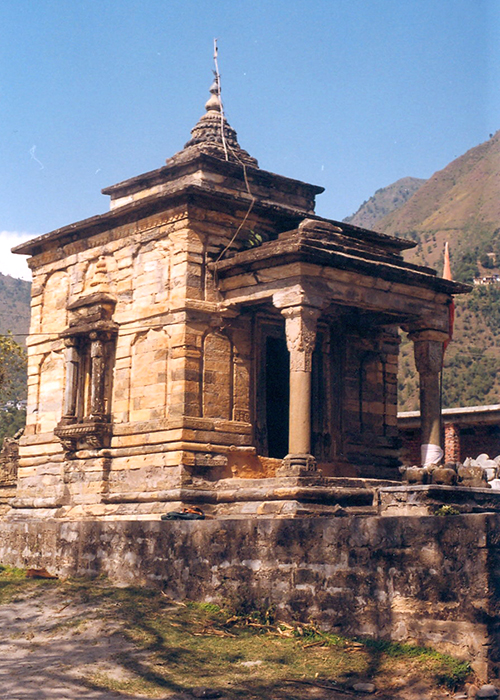
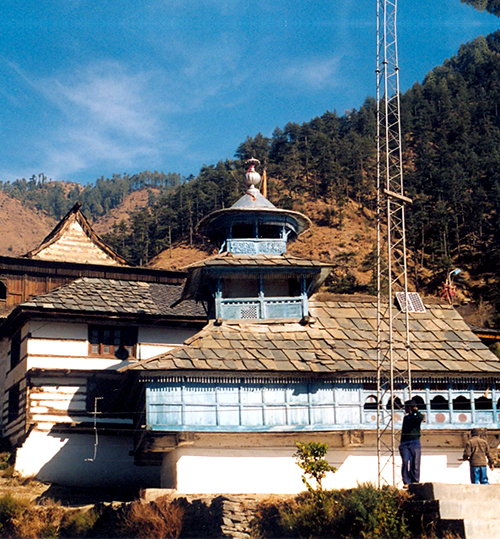
MAGRUMAHADEV TEMPLE, CHHATRI, THUNAG, MANDI
The glorious monument,MagaruMahadev Temple at Chhatri village, is known for its marvellous woodcarvings.The Chhatri village is situated at a distance of 50 Kilometres from Karsog and 160 kilometres from Shimla.
The architecture of this temple is a combination of pagoda and mandap style. The sanctum sanctorum is not perfect square but it is oblong in shape. Walls of sanctum are constructed in Kath–Kuni masonry. This portion rises in three tiered pagoda. There are two circumambulatory paths of varied width surrounds the sanctum. Gabled roof portion covers the both circumambulatory paths and mandap. The topmost roof of pagoda, which is of conical shape, is covered with Plain Galvanised Iron sheets over four layers of wooden planks. The middle tier is covered with slates over three layers of planks. The lowermost roof, which forms a gable end in front, is covered with slates over two layers of wooden planks
The most interesting part of this temple is the elaborate and gracefully stylised woodcarving in the mandap. Every inch of the exposed wooden part in themandap is minutely and richly carved, and not a single figure, zoomorphic or anthropomorphic is static or frozen, but brimming with activity. Even the serpents, with their zigzag formation appear to be in swift peristaltic motion. So are the elephants and horses high-spirited.
The woodcarver has very successfully executed numerous episodes and themes drawn from the Indian Epics, the Ramayana, and Mahabharata. The treatment of the battle themes is particularly interesting. It is very forceful and captivating. The ceiling over the mandap has very ingeniously been made dome-shaped. It is very richly carved with the dancing human figures, regimented along the rim of the dome, succeeded the bands of creepers, floral devices, etc.
RADHA KRISHN TEMPLE, DADASIBA, KANGRA
Raja Ram Singh (Siba state) and his subject were the devotees of Krishn. It is said that they used to visit Mathura and Brindavan on pilgrimage. As the tradition goes, Ram Singh is known to have suggested his subject the idea of construction a temple for Krishn at Dada Siba so that they did not have to visit the distant Mathura- Brindavan. Accordingly, he selected a site among a grove and built a temple. It is said the each of the twenty-two administrative units, called teeke, used to perform service for the construction of this temple. The red sandstone for this temple was imported from Agra and marble from Jaipur-Jodhpur. It took 18 year to complete this temple. The temple was consecrated on the Nag Panchami of VikramiSmavat 1831, corresponding to AD 1888. The temple enshrine back marble images of Krishn and a brass image of Radha.
The temple is richly embellished with the murals, executed in panels, on the inner surfaces of the entire temple, comprising the central garbh-grih and the flanking shrines. Who were the painters of these murals is a contentious issue: According to the pujari of this temple, two painters, Suba Ram and Devi Chand, executed these murals. However, KanwarRajbindar Singh asserts that the names of those two painters were Mathura Dass and Devi Chand. Notably, there is equanimity about the home of those painters. They belonged to Bhunga-Haryana village in the Hoshiarpur district of Punjab and they were mason-cum-painter.
The temple is built on an elevated plinth, having octagonal extension on all the four corners. The garbh-grih of this temple is in the shikhar style laid on the tri-rath plan. It has a domed ceiling, embellished with paintings. On the sidewalls of the garbh-grih, trellised windows. The floor is of marble. The silver plated door of garbh-grih is elaborately chased. It also carries an inscription.
The octagonal mini-shrine on the sides of garbh-grih have domed ceiling. These mini-shrines are elaborately painted.
The mandap part is roofed with a set of three domes, the central one being larger to the ones on the sides. The wagon-vault ceiling of the mandap is fully and richly painted.
The overall architecture of this temple presents a mixture of the classical and Muslim mannerism. While the shikhar of this west-facing temple, though deformed, may be seen influenced by the classical parameters, the domes mandap clearly reflect the Muslim influence.
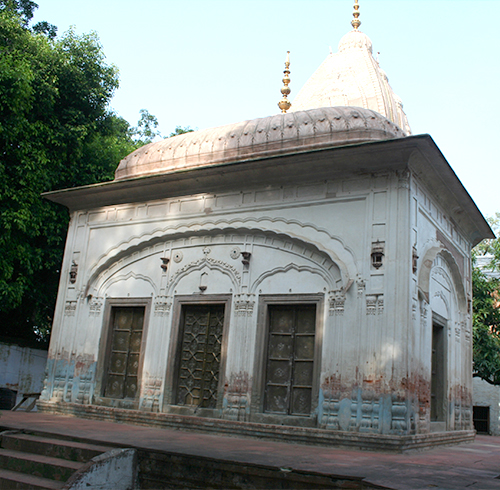
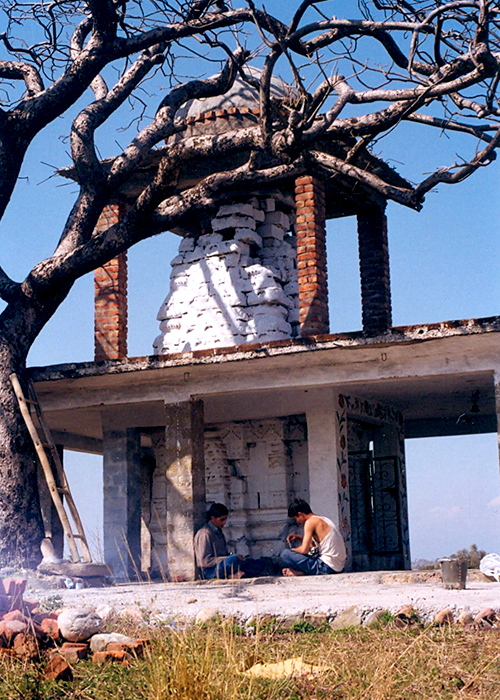
SHIV TEMPLE, AMMAN, BHORANJ, HAMIRPUR
This temple is situated on the local mound on right side of the Didwin-Tikkar-Tal-KerwinMor link Road at a distance of 16 kilometres from Hamirpur, in village Amman, Tehsil Bhoranj, of district Hamirpur. Another approach to this village is from KerwinMor, an off-taking point on the Hamirpur-Lambalu-Jahoo Road. This unicellular temple laid out on the tri-rath plan measures 1.27 metres square internally. Externally, it measures 2.20 x 2.65 metres, which also includes the narrow ardh-antral on the front. The mini-antral has an extended spired pediment. The height of this temple structure, as it exists now from the sill level to skandh is 5.00 metres. The temple faces east.
From its special characterising features, it shows that this temple is coeval with the ancient non-existent Shanmukheshwar temple at Old Bilaspur and the ruins at Auhar. Thus, it should belong to 7th -8th century at the latest. May be a bit earlier. Later on the dating of this temple was confirmed when a hoard of Indo-Sessenian coins were found during the excavation in the complex.
Although, it may not be immediately possible to find out the circumstances that had been responsible for the construction of this temple at such a far off and interior place of Hamirpur district, but certainly it must have been a reputed place of worship near a small township. The name of two places – Tal and Mahal just about three kilometres south of this temple may indicate that a capital centre of a small principality might have existed about this place. The ruins of an ancient fort at Mahal also corroborate such possibility.
JANAKI DAS TEMPLE, KANGRA
Jaisinghpur is a tehsil headquarters of a tehsil of the same name in the Palampur subdivision of Kangra district. Located on the right bank of the Beas, this town is 50 kilometres from Palampur and 90 kilometres from Dharamshala.
As the tradition goes, one of the Katoch rulers of Kangra built this temple in the memory his daughter. Her name was Janaki, hence the name of the temple was kept as Janakinath.
This late eighteenth century temple, facing west, has been build on the pattern of the Vaidyanath temple at Baijnath (Kangra). Although, the plan of this temple fully replicated the Baijnath prototype, yet architecturally it is a folkish and crude copy of that classical temple. Fronting the temple is an independent enclosure, the garud-mandap. In it, a stone image of garud, facing the temple, is installed on the analogy of Nandi in front of Vaidyanath temple. The temple is laid out on the classical parameters, with mukhmandap, large square mandap, antaral and garbh-grih. The area of temple is well defined by a high stone masonry boundary wall
The garudmandap is an open stone masonry structure covered, with the stepped stone roof resting on the four pillars. In the middle of this mandap, black stone image of the udyatgarud is installed, with its hand joined together in adoration. The image is partly painted with the ochre pigment.
The mukhmandap is a pavilion-type fronting structure with four pillars, supporting the stepped stone roofing, on which a crude amakak is placed. The roofing pattern is exactly similar to the roof of the garudmandap. The square mandapof this is of a reasonably large size. The floor of this mandapis paved with the marble tiles. In the middle of the floor, there are four massive stone pillar located equidistantly. Between these pillars two elevated platform are built on both the sides. There are two projected bay windows in the mandap towards the south and north. The openings of these windows are fitted with the stone screen. On the external corners of the four-walls of the mandap, there are inset mini minarets.The massive stone pillars and the four-wall of mandap support a grid of massive monolith stone beams. On those beams, a stepped flagstone roof, surmounted by an amalak, is provided. The antaral is an intermediate area between the mandap and garbh–grih.
The tri-rathgarbh–grihis a completely dark and plain, with a shallow niche on the eastern wall. The black stone images of Ram, Sita and Lakshman are installed in the garbh-grih eccentrically towards the left.
The superstructure of grabh-girhis raised on the tri-rath plan in an attenuated spire to form a shikhar. On the top of shikhar, a massive amalak is installed.

